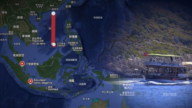【新唐人2015年01月02日讯】日前历经50年论证、12年建设的南水北调工程的供水日前进入北京。尽管中共官方不断加大宣传力度,但这项所谓的“政绩工程”从论证到展开工程,却和另一个大型水利工程三峡大坝一样,一直在争议声中进行着。更有专家指出,南水北调工程的隐患比三峡工程更为严重,很有可能成为中原大地的灾难根源。
中共媒体报导,在刚刚过去的2014年12月27号,南水北调中线一期工程总干渠终点团城湖明渠开闸放水,北京市南水北调工程正式通水。报导称,“南水”年均将为北京送水10.5亿立方米,除延庆外,其余15区县可喝上“南水”。
南水北调中线工程,是从湖北与河南交界的丹江口水库引水,途径河南、河北两省,抵达北京和天津。
尽管中共当局近期不断加大宣传力度,藉各方专家论证为这项备受争议的工程“漂白”,舆论对这一通水时刻却没有报以“敲锣打鼓般的”庆祝。它的可行性以及对生态环境的冲击,都受到相当的关注。
多家海外媒体对这项工程进行相关报导时,都引述了大陆的数据来源称,南水北调中线工程耗资达330亿美元。按照6.2的汇率换算,约为人民币2,046亿元。
《新华网》在2003年工程启动时曾披露,南水北调中线一期工程规划总投资920亿元人民币。由此推算,工程完工的实际耗资高达预算的2.2倍。
同时,这些海外媒体也不约而同的提到,由于南方降水量减少,调水工程只能算是暂时充当解决北方水资源不足的权宜之计。
《德国之声》引述美国波特兰州立大学助教布里特•克劳•米勒的观点认为,这种把后果推到将来的发展模式非常短视。
同时,沿途水资源严重污染的问题,可能会使到达北方的水无法再使用。
北京环保人士、“乐水行”发起人张峻峰:“从生态学原理角度上分析,可能对调水地区的影响要远远大于受水地区的影响。而这个影响是长期持续的。在人工的这种设置情况之下,一定会改变自然运作,或者对自然的演化进程会产生一些扰动,这是毫无疑问的。”
12月19号,一位署名为“马可安”的美国物理学博士,在网上发表质疑南水北调工程的评论文章,从水污染、泥沙淤积和经济效益等多个层面论证,工程将以失败告终。文章引发大陆民众的广泛关注,并被大量转发。
中共央视、《新华网》等官方媒体随后加大宣传力度,藉各方专家之口进行反驳,并论证南水北调工程不会“半途而废”。
旅居德国的中国环境问题专家王维洛认为,这是中共对于批评意见极力封杀的一贯做法。
王维洛:“他(中共)不喜欢听一些反对的声音,只是找一些知识份子对他们的决策做一些注释,为他们的决策做一些所谓的科学的论证。中国知识份子也是讲名利的。这是获得名利的途径,只要你唱赞歌的话。
对于南水北调采取明渠运河的输水方式,王维洛认为,南水北调工程并没有航运的任务,明渠上面也不通船,但是它可以成为宣传的手段。
王维洛:“明渠的输水形式没有航运的话,它是一个最差的选择。但是明渠的这个输水管道它有一个好处?就是它可以拍电视,可以拍照片,可以拍航照让大家看。你看我这个东西多伟大。但是你如果用暗管的话你什么也看不见。
王维洛还表示,跨流域的大调水工程,违反可持续性发展的理念。南水北调工程,从汉江调走如此巨大的水量,意味着从另一个地区掠夺今后发展所需要的资源,在汛期及干旱时将可能发生不可预期的严重后果,隐患比三峡工程更大、威胁的面积更广,甚至有可能成为中原大地的灾难根源。
采访/易如 编辑/李明飞 后制/钟元
South Water Diverted to Beijing—A Blessing or a Curse?
Beijing has recently started receiving water through
the South-North (S-N) Water Diversion project—a result of
50 years of studies and 12 years of construction.
Although the Chinese Communist Party (CCP) continues to
step up its publicity efforts, the “vanity project" has been
conflicted with controversy from the start,
it being similar to the Three Gorges Dam project.
Experts say the S-N Water Diversion poses far greater risks
than the Three Gorges and is set to become the scourge of
the Central Plains.
The CCP’s official media reported on Dec. 27, 2014 that
a water gate at the south end of a major channel from
Tuan Cheng Lake had been lifted, setting in motion Phase 1
of the S-N Water Diversion’s middle route for Beijing City.
The report says the “southern water" will supply Beijing with
1.05-billion cubic-meters of water annually.
As well as Yanqing County, all other 15 counties and districts
of Beijing will be supplied with the southern drinking water.
The project’s middle route extracts water from Danjiangkou
Reservoir at the border between Hubei and Henan Province,
and passes through both provinces before reaching Beijing
and Tianjin.
The Chinese authorities have been continuing to increase
their publicity efforts by getting various “experts" to verify
the advantages of the project and whitewash the dangers.
However, public opinion shows considerable concern over
the project’s feasibility and its ecological impact.
When a number of overseas media reported on the project,
they all cited the data from Mainland China, saying that
the middle route of the Diverting South Water to North
project had cost up to 33-billion US dollars.
With the exchange rate of 6.2,
this approximates to 205-billion yuan.
When the project started in 2003, Xinhua News net disclosed
that Phase 1 of the project’s middle route was planned to
cost 92-billion yuan—meaning the actual cost on completion
was more than twice the amount of the initial budget.
Foreign media invariably mentioned that due to the reduced
rainfall in southern China, the water diversion could only be
considered a temporary fix for water shortages in the north.
Deutsche Welle quoted Assistant Professor Britt Crow-Miller
from Portland State University in Oregon, saying that
such a development pattern of postponing the negative
consequences to the future is very short-sighted.
Meanwhile, severe water pollution along the diversion route
may deem the water unusable by the time it reaches north.
Zhang Junfeng, Beijing Environmentalist and Founder of
Journey for Loving Water: “From the perspective of ecology,
potential impacts on areas where the water is taken from,
is much larger than those where the water is diverted to,
and the impact is long-lasting; under artificial conditions
the natural process and evolution is undoubtedly disturbed."
On Dec. 19, American netizen, Mark Ann, who holds a PhD
in physics, published a review that questioned the diversion
project from multiple levels, such as on water pollution,
sand siltation and economic benefits.
Mark Ann concluded that the project would eventually fail,
which sparked widespread concern from mainland Chinese,
who forwarded the article widely.
Chinese Central TV (CCTV), Xinhua News and other official
CCP media followed the increasing publicity efforts,
using the mouths of various experts to refute negativity
and prove that the project will not “fall by the wayside".
Chinese environmentalist, Wang Weiluo, who lives in
Germany, says it’s typical for the CCP to ban criticism.
Wang Weiluo: “The CCP doesn’t like to listen to opposition;
it looks for some intellectuals who will positively interpret
and support its decisions, while offering some so-called
‘scientific evidence’ to prove how correct the CCP is."
“The intellectuals are also pursuing fame and self-interest
and they can get these, as long as they praise the CCP."
Wang Weiluo says the diversion channel offers no shipping,
but will be used as a means of propaganda.
Wang Weiluo: “Having an open channel that doesn’t serve
any shipping functions is the worst choice."
“But an open channel aqueduct can be good for TV shots,
photos and aerial shots—the CCP uses these to show off;
with underground pipes, you can’t see anything."
Wang Weiluo says such a dramatic inter-basin water transfer
project violates the concept of sustainable development.
The Water Diversion Project transfers such a huge amount of
water from the Han River to northern China, that it equates
to plundering the resources needed for future development
of the southern regions.
It can lead to serious consequences during periods of
flooding and drought.
The project poses greater risks and threatens wider areas
than the Three Gorges Project; it’s likely to become
the scourge of the Central Plains.
Interview/YiRu Edit/Li Mingfei Post-Production/ZhongYuan






























